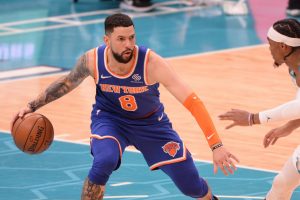A year ago, Bucks forward Giannis Antetokounmpo won the NBA’s Defensive Player of the Year award, with Lakers big man Anthony Davis and Jazz center Rudy Gobert finishing as the second- and third-highest vote-getters, respectively.
Antetokounmpo is a perennial candidate for the award, but he has missed a little time with injuries this season and Milwaukee’s defense in 2020/21 (109.6 rating; sixth in the NBA) isn’t as dominant as it was last season, when the team ranked first with a 102.5 defensive rating. He’ll probably get some votes, but he’s unlikely to repeat as the DPOY.
The Lakers have the league’s best defensive rating so far this season (105.5), and Davis has played a major part in the unit’s success when he’s healthy. But he has only played in 23 of L.A.’s 55 games so far and remains sidelined for the time being, essentially removing him from the DPOY conversation.
Of last year’s top three finishers then, Gobert looks like the best bet to take home the award in 2021. He has won it twice already, and the Jazz have the NBA’s best record at 41-14. Gobert, as usual, has anchored their defense, which is the league’s fourth-best (107.6 rating), and he’s leading the league in DRPM (defensive real plus-minus) by a wide margin.
Still, Gobert isn’t a lock to earn Defensive Player of the Year honors. He has struggled to slow down many of the league’s top centers in their head-to-head matchups this season, allowing Nikola Jokic to average 41 points, 13 rebounds, and seven assists in his two games against Utah, while Joel Embiid racked up 40 points and 19 boards in his lone matchup with Gobert.
Another Sixers All-Star, Ben Simmons, scored 42 points against Gobert and the Jazz in the game Embiid missed, something he recently pointed out on ESPN’s The Jump when making his own case for Defensive Player of the Year.
“I’m one of those guys who can guard one through five,” Simmons said, per Ky Carlin of SixersWire. “Obviously, there’s a lot of respect for Rudy. I know what he’s capable of. I know he’s great down there in the paint, but he’s not guarding everybody and that’s just what it is. He guarded me in Utah…I had 42, and apparently I’m not a scorer. It is what it is, but I have a lot of respect for him. At the same time, I think it’s mine this year.”
Simmons, who finished fourth in the 2020 vote, has been a key part of the NBA’s second-best defense this season (106.6 rating), and his versatility makes him an intriguing candidate to win the award. However, as Rich Hofmann and Andrew Patton note in a piece for The Athletic, Simmons doesn’t necessarily stack up well to other top candidates based on publicly available advanced stats, even if those stats perhaps underrate his contributions.
Pacers center Myles Turner has a legitimate case for Defensive Player of the Year honors this season, posting an eye-popping 3.5 blocks per game to lead the league. He ranked second in Steve Aschburner’s recent breakdown of DPOY contenders at NBA.com. Still, Indiana is a sub-.500 team (26-28) with a middle-of-the-pack defense (111.5 rating; 13th in NBA), which will work against Turner’s case.
Hawks center Clint Capela has been making a strong push for DPOY consideration as well, as Chris Kirschner of The Athletic details, ranking in the top two or three in a handful of advanced stats, as well as third in the NBA in blocked shots (2.2 per game). Although the Hawks’ defensive rating (112.1) is just 19th in the league, that’s a significant improvement on last season’s showing (28th), as Capela has been discouraging shots around the rim, and has been better at preventing the attempts that are made.
What do you think? Who would be on your three-man Defensive Player of the Year ballot, and who do you view as the frontrunner? Which players not mentioned above would you consider?
Head to the comment section below to share your thoughts!
 However, teams may look first as players who have been in the NBA more recently. That list includes vets like
However, teams may look first as players who have been in the NBA more recently. That list includes vets like  Justise Winslow
Justise Winslow